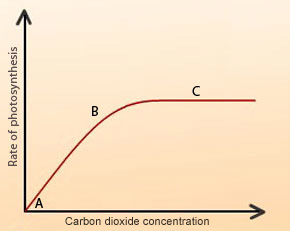Factors affecting the rate of photosynthesis
3. Carbon Dioxide
Carbon dioxide is used to make sugar in the photosynthesis reaction. The concentration of carbon dioxide in the Earth’s atmosphere varies between 0.03% and 0.04%. An increase in the concentration of carbon dioxide gives an increase in the rate of photosynthesis. It is difficult to do this out in the open air but is possible in a greenhouse.
Gradually the rate falls of and at a certain carbon dioxide concentration the rate of photosynthesis stays constant (from point B to C on the graph). Here a rise in carbon dioxide levels has no affect on the rate of photosynthesis as the other factors such as light intensity become limiting. |
Many crops such as tomatoes and lettuce give higher yield when grown in greenhouses. Farmers add additional carbon dioxide into the greenhouse to increase the concentration and so the rate of photosynthesis of the crops. The additional cost of the carbon dioxide is worthwhile because of the increased yield.
Some companies have used this to great environmental use. Rather than pump waste carbon dioxide into the atmosphere as a pollutant they redirect it into big greenhouses where plants such as tomatoes use it during photosynthesis. This not only reduces their carbon footprint but gives an additional profitable product.
 The rate of photosynthesis increases linearly with increasing carbon dioxide concentration (from point A to B on the graph).
The rate of photosynthesis increases linearly with increasing carbon dioxide concentration (from point A to B on the graph).